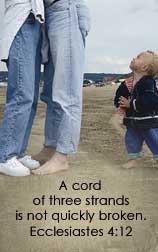I have no idea where she learns these things! She's crawling along the back of the couch and jumping on my legs. I keep telling her no. Just now she went on the back of the couch to do it again and I told her no. She said, "OK, Mama. One more." No, not one more! Where does she learn this? lol
Sunday, May 24, 2009
Car Seat Safety! Please Read & Pass On!

Post written by Laura Bower
Sure, we strap 'em in, hopefully nice and tight, chest clip level with the armpit, not able to pinch the webbing of the harness together at the collarbone (visual here - http://www.carseatponcho.c
Before you start wringing your hands worrying that this is going to cost you money and possibly money that you don't have, in the area of car seats, thankfully exponential price does not equal exponential safety. Chances are that the equipment you already have is fine (it is important to check that your car seat has not been in a crash or has not expired though - usually that is 6 years following the date of manufacture.) Thankfully, the safest car seat is one that fits your budget, your child, your vehicle and which you use 100% correctly 100% of the time.
To tell if your car seat is installed tightly enough, it should not move when lightly tugged at the belt path (where the seat or LATCH belt threads through the car seat) more than 1 inch side to side, or front to back. It is best to make an appointment with a Child Passenger Safety Technician (CPST) to have your car seat installation and usage checked professionally. This is a FREE service and you can locate your nearest tech. through this website - http://www.safekids.org/ce
It's important to note that every promotion through different stages of car seats is a demotion in safety for your child. So let's take a little trip along the stages of your child and their life-cycle through car seats.
When your little one makes their (hopefully) smooth entrance into the world, you will be taking them home in an infant car seat. This is sometimes referred to as a 'bucket seat'. It's the type with the handle which attaches to a base in your vehicle and can be removed from the base with baby still inside as you go to the grocery store, for example. (Now, please do not balance your infant seat on the top of your grocery cart - it should be placed inside the basket.) The infant seat is a rear-facing seat which goes from around 4lbs - 22lbs, though some do go to 32lbs today.
There is a golden rule to follow, and it particularly seems to apply to the infant seat stage (as in, it is the most ignored rule at this stage) - if it didn't come in the box with the car seat, it's not safe to use it. So that means, all those cute little head pillows/harness strap covers/dangling toys/JJ Cole Bundleme's are not safe to use with your seat. Your seat was not crash tested with these items and their use may affect the seat's performance adversely in a crash....so please walk on by that section of the car seat aisle....m'kay? The harness should be routed in the slots in your infant seat which are either at or below your child's shoulders. Do not move the strap up to the next slot until your child's shoulders are even or slightly above the next slot. The infant seat should be installed so that there is a 45 degree recline angle - your seat, or the base, will have a recline angle indicator to help you get that correct. This is important, especially with young infants, to keep their airway open until they get good neck control.
Ok - so junior is getting big in his car seat. Well, how do you know if the infant seat has been outgrown? Junior has either reached the maximum weight limit for the seat, OR there is less than 1 inch of hard car seat shell above his head. Leg length/legs touching the vehicle seat back are not a concern, nor an indicator of the seat having been outgrown. Some people chose to move their infant over to the next stage of seat (the convertible seat) once the combination of Junior and the infant seat gets too heavy to lift. You can of course continue to use the infant seat until it is outgrown by weight or height and leave the seat in the vehicle and just put Junior in and out of the seat in the car.
So onto the convertible seat, so named because it can convert from a rear-facing to a forward-facing seat. First, an important note about rear-facing and this can get a little technical, but I'll try to keep it light. The statistics are that rear-facing is 5 times safer for your child than forward-facing. Because a picture (or in this case, a video) can tell a thousand words, here is footage of a rear-facing crash test - http://www.youtube.com/wat
Ok, Junior has reached a rear-facing limit, so now is the time to turn that convertible seat around. Remember, you've just decreased his safety by 5 times. Some things need to happen before you install that seat forward-facing. If you are using either the LATCH or the seatbelt belt to install your seat, you will need to change how the belt is routed through the seat and use the forward-facing belt path. There should be stickers on the seat to help you locate that. You also need to move the harness into slots which are at or above your child's shoulders. Finally, always use the top tether strap/anchor on your car seat when forward-facing. It will reduce the amount your child's head is thrown forward (remember the video above) by between 4 and 6 inches. If you have a vehicle that was manufactured before 2001, you may not have top tether anchors in your vehicle - don't panic! They can be retrofitted into your vehicle and often for free. Your local CPST can provide you details on part # and free retrofit programs for your vehicle. Junior is going to outgrow this convertible seat when one of the following three things happen:
1) The top of the child's shoulders creep above the top harness slot.
2) The child reaches the maximum harness weight.
3) The top of the child's ears are level with the top of the shell of the seat.
When one of these things happen, it's time for a new car seat.
Ok - so the convertible seat has been outgrown, what next? A booster? Woa....hold your horses there partner!!! That may not be the best choice. Remember the mantra, every promotion in car seat is a demotion in safety. It is always safer to continue to keep your child in a harnessing seat for as long as possible - more information on that is available on this webpage - http://www.kyledavidmiller
There are a set of minimums your child must reach before you can safely transition them to a booster seat using the vehicle seatbelt:
1) The child should be a minimum of 40lbs
2) The child should be a minimum of 4 years old
3) The child should have the maturity to sit correctly in the booster seat - that is upright and still for the entire ride - no wriggling around, reaching for toys, or slumping forward when they fall asleep.
Because of point 3 above, generally, children younger than 6 years old are not ready to sit safely in a booster seat. Now, be careful when you are choosing your booster seat. Just like a car seat, not all booster seats are compatible with your vehicle or child. A correct fit on a booster seat places the belt low on the body - touching the hips. The lap portion of the seatbelt should NOT be across the abdomen of the child. The shoulder portion of the belt should be across the chest and the middle of the shoulder, NOT touching the neck. If the booster does not position the belt like that on your child, you need to try out another booster seat. It is preferable to use a high back booster seat as this provides side impact protection for your child's head, as shown in this video http://www.youtube.com/wat
OK - so many of you will have seen that booster seat laws are being introduced to your State. Usually a booster seat law says something like you need to use a booster seat until your child is 8 years old or 80lbs. Well, that's the law.....but that is not actually what you need to do to keep your child safe. A booster seat should be used until your child can pass what is called 'The 5 Step Test' - http://www.carseat.org/Boo
1) Does the child sit all the way back against the auto seat?
2) Do the child's knees bend comfortably at the edge of the auto seat?
3) Does the belt cross the shoulder between the neck and the arm?
4) Is the lap belt as low as possible, touching the thighs?
5) Can the child stay seated like this for the whole trip?
If you answer no to any of these, you need to continue to use a booster. The average child needs to use a booster until they reach around 10-12 years of age. Until that time, the adult seatbelt, which was designed to fit an adult male of ~ 200lbs, they need a booster seat to make the belt fit them correctly. Without it, a child can suffer internal injuries or ejection from the belt.
Wow! Are you still with me? Yes, that's a LOT of information there, but only small parts apply to you at various stages of your child's graduation through seats. There is a lot to know about correctly installing and using your car seat. Always read both your vehicle manual and the car seat manual. Always make an appointment with your local CPST who will teach you how to correctly install and use your car seat. Always do your research, and please, ALWAYS do your best for your children with regards to car seat safety.....it might just save their life!
 Posted by
Milk Mama
at
9:10 PM
0
comments
Posted by
Milk Mama
at
9:10 PM
0
comments
A Nice Compliment

We just went to the store and in the parking lot when we were getting ready to go home, a lady came up to me and told me, "Your daughter is beautiful." She said that her daughter (also named Anna) saw her in the store and thought she was adorable. Those kinds of things are just so good to hear. Not necessarily for vanity's sake but because it's just good to hear people compliment your children. :)
I had Anna's hair in a pony tail. Very cute. I'll share soon.
But I took this photo the other day and thought it was adorable:
 Posted by
Milk Mama
at
8:14 PM
0
comments
Posted by
Milk Mama
at
8:14 PM
0
comments
Sunblock!

I realized today that our sunblock was expired! That could have been very bad! Make sure you check your sunblock expirations!
Paul read to me today that olive oil is an excellent moisturizer, that you can put some in a warm bath to moisturize skin, and that it's also an excellent skin cancer preventative. I knew it was good as a moisturizer, but as a preventative measure against skin cancer... that's news to me! I'll be trying it out in my baths for now on!
 Posted by
Milk Mama
at
6:25 PM
0
comments
Posted by
Milk Mama
at
6:25 PM
0
comments









